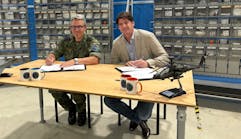Oct. 5—NORTH MANKATO — Kato Engineering has been awarded its largest single contract ever — a $90 million project to power the catapult system that will launch aircraft from the newest U.S. Navy aircraft carrier.
Work is already underway at the North Mankato-based company to provide the energy storage subsystems for the USS Doris Miller, the Ford-Class aircraft carrier scheduled to be constructed starting in 2026 in Newport News, Virginia.
Delivery of the systems will begin in 2025 and will continue through 2027, according to Jim Twardowski, vice president defense at Kato Engineering.
"This is the fourth aircraft carrier that we have supplied or will supply the ESS for," Twardowski said.
It's the first time, though, that Kato Engineering was awarded the prime contract for the power system by Naval Air Systems Command Headquarters, known as NAVAIR, after previously supplying the system through another company that received the contract for the broader catapult system on the USS Gerald Ford, the USS John F. Kennedy and the USS Enterprise.
For the USS Doris Miller, the Navy came directly to the 97-year-old manufacturer of electric generators/alternators, energy storage products and specialty electric motors.
"That shows the trust that they have in our level of service that's really been demonstrated over the shipping of the last three (ships)," Twardowski said.
The new Ford-Class carriers, which carry a projected cost of roughly $12 billion apiece, use electromagnetic aircraft launch systems rather than the traditional steam powered versions.
The electromagnetic system is similar to what is used in high-speed maglev passenger trains and even in some modern rollercoasters. The systems are more expensive and complex than the ski-jump-type ramp that many nations' navies are building into their carriers to launch aircraft.
But the electromagnetic system can launch larger, heavier aircraft, pushing a 100,000-pound aircraft to a speed of 150 mph in 300 feet, according to a story in NavalPost. The U.S. Navy's shipbuilding plan is to add two new carriers every decade.
"What's exciting for us is the carrier program is every five years, so we are able to produce these on a fairly consistent basis with all the subsequent (contract) awards," Twardowski said.
Now, the French Navy is looking to use the same launch technology on its newest carrier.
"We are working to supply our ESS system for that as well," he said.
High-quality power systems are also going to be needed more and more for other types of military vessels, both new and retrofitted, to meet the ever-growing electrical power demands of modern radar and weapons systems.
"Being awarded this as a prime contract also elevates Kato Engineering's name within defense circles, and that will help us capture additional business moving forward," Tawardowski said.
Founded in 1926, Kato Engineering — which also has a plant in Lexington, Tennessee — is now part of Nidec's Motion & Energy of St. Louis. Nidec's Kato Engineering President and General Manager Kevin Newman announced the new contract by touting Kato's long history of providing components for Navy ships.
"We have been supplying power generation solutions onboard US Navy ships for decades and our intention is to continue to do that for decades into the future," Newman said in a statement released by the company.
Along with the value of that historic relationship, Newman credited Kato's "highly skilled workforce" in garnering the contract.
Twardowski noted that the workforce isn't quite as large as the company would like, directing prospective employees to check out openings at katocareers.com.
___
(c)2023 The Free Press (Mankato, Minn.)
Visit The Free Press (Mankato, Minn.) at www.mankatofreepress.com
Distributed by Tribune Content Agency, LLC.


